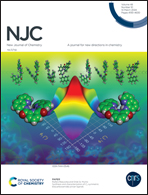Visible light-driven cubic structured NiFe2O4@MWCNTs/TiO2 ternary nanocomposite for photocatalytic degradation of ciprofloxacin
Abstract
A nanocomposite (TiO2/NiFe2O4@MWCNTs) was synthesized through hydrothermal methods, combining NiFe2O4, TiO2, and MWCNTs. The material underwent characterization using various analytical methods, including XRD analysis, SEM, TEM, EDS, UV-vis spectroscopy, PL analysis, FT-IR, Raman spectroscopy, and BET analysis. The average size of a nanoparticle is 36 nm, as determined by transmission electron microscopy and the Scherrer formula. UV-visible examination reveals that the TiO2/NiFe2O4@MWCNTs nanocomposite has an energy band gap of 1.5 eV. The resultant nanocomposite has a specific surface area of 70.5 m2 g−1 and a pore volume of 0.29 cc g−1. These analyses demonstrated that the inclusion of MWCNTs effectively inhibited charge carrier recombination in both NiFe2O4 and TiO2 nanoparticles. The catalyst's efficiency was evaluated in a batch reactor under diverse conditions, including different nanocomposite dosages, CIP concentrations, and pH levels. The degradation of CIP was explored through photocatalytic experiments with varying nanocomposite dosages, revealing that a dosage of 0.5 g L−1 resulted in an 83.5% degradation efficiency (CIP: 40 mg L−1, pH = 6, 120 min, 120 W m−2). Different CIP concentrations were also tested, showing that a concentration of 10 mg L−1 achieved a degradation performance of 93.5% (catalyst: 0.5 g L−1, pH = 6, 120 min, 120 W m−2) and an efficiency of 97.2% at a pH of 10. The optimal conditions for CIP degradation were determined as 0.5 g L−1 of nanocatalyst, a CIP concentration of 10 mg L−1, and a pH of 10. These optimal parameters were then applied to assess CIP degradation using NiFe2O4 and NiFe2O4/MWCNTs as individual materials. Trapping analyses have established that H+ and OH˙, which are reactive radicals, are the main agents responsible for the breakdown of CIP. The highest agreement with the experimental data was obtained by applying a pseudo-first-order kinetic model, which had an R2 value of 0.97 for a range of CIP concentrations. Notably, even after four consecutive uses, the photocatalysts maintained their original efficiency, experiencing a minimal decrease of less than 3.2% in CIP degradation. Due to its straightforward synthesis, excellent stability, and potential for recycling, TiO2/NiFe2O4@MWCNTs demonstrated promising performance in degrading CIP antibiotics, suggesting its suitability for removing and breaking down pharmaceutical organic contaminants in water systems.



 Please wait while we load your content...
Please wait while we load your content...